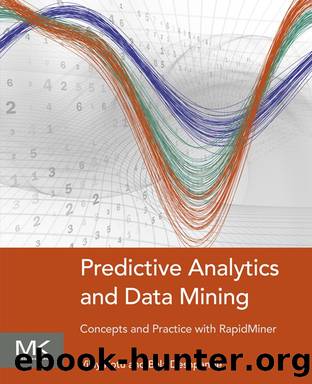Predictive Analytics and Data Mining by Vijay Kotu & Bala Deshpande

Author:Vijay Kotu & Bala Deshpande [Kotu, Vijay & Deshpande, Bala]
Language: eng
Format: epub
ISBN: 9780128016503
Publisher: Elsevier Science
Published: 2014-12-02T12:07:43+00:00
Keywords
Association; recommendation; frequent items; Apriori; FP Growth; support; confidence; market basket analysis; transaction analysisThe beer and diaper association story in Analytics circle is (urban) legendary (Power, 2002). There are many variations of this story, but the basic idea is that a supermarket company discovered that customers who buy diapers also tend to buy beer. The beer and diaper relationship heralded what unusual, unknown, and quirky nuggets can be learned from the purchase transaction data of a supermarket. How did the supermarket determine such a relationship between products existed? Answer: data mining. Specifically, association analysis.
Association analysis measures the strength of co-occurrence between one item and another. The objective of this class of data mining algorithms is not to predict an occurrence of an item, like classification or regression do, but to find usable patterns in the co-occurrences of the items. Association rules learning is a branch of an unsupervised learning process that discovers hidden patterns in data, in the form of easily recognizable rules.
Association algorithms are widely used in retail analysis of transactions, recommendation engines, and online clickstream analysis across web pages. One of the popular applications of this technique is called market basket analysis, which finds co-occurrences of one retail item with another item within the same retail purchase transaction (Agrawal et al., 1993). If patterns within data tell us that baby formula and diapers are usually purchased together in the same transaction, a retailer can take advantage of this association for bundle pricing, product placement, and even shelf space optimization within the store layout. Similarly, in an online business setting, this information can be leveraged for real-time cross selling, recommendations, cart offers and post purchase marketing strategies. In the case of retail business, many of the association rules results are commonly known, for example a burger with fries or baby formula with diapers; however, uncommon relationships are the prized discoveries, the ones businesses can take advantage of. The downside is association analysis may also yield spurious relationships between items. When dealing with data containing billions of transactions, we would find transactions with all kinds of possibilities with strange combinations of item sets (e.g., nicotine patch and cigarettes). It takes analytical skill and business knowledge to successfully apply the outcome of association analysis. The model outcome of an association analysis can be represented as a set of rules, like the one below:
Download
This site does not store any files on its server. We only index and link to content provided by other sites. Please contact the content providers to delete copyright contents if any and email us, we'll remove relevant links or contents immediately.
Algorithms of the Intelligent Web by Haralambos Marmanis;Dmitry Babenko(7851)
Learning SQL by Alan Beaulieu(5411)
Weapons of Math Destruction by Cathy O'Neil(5036)
Big Data Analysis with Python by Ivan Marin(3005)
Blockchain Basics by Daniel Drescher(2890)
Hands-On Machine Learning for Algorithmic Trading by Stefan Jansen(2516)
Pandas Cookbook by Theodore Petrou(2500)
Mastering Python for Finance by Unknown(2474)
Building Statistical Models in Python by Huy Hoang Nguyen & Paul N Adams & Stuart J Miller(2467)
Azure Data and AI Architect Handbook by Olivier Mertens & Breght Van Baelen(2435)
Serverless Machine Learning with Amazon Redshift ML by Debu Panda & Phil Bates & Bhanu Pittampally & Sumeet Joshi(2370)
How The Mind Works by Steven Pinker(2213)
Data Wrangling on AWS by Navnit Shukla | Sankar M | Sam Palani(2152)
Building Machine Learning Systems with Python by Richert Willi Coelho Luis Pedro(2058)
Data Engineering with dbt by Roberto Zagni(2049)
Driving Data Quality with Data Contracts by Andrew Jones(2020)
Network Science with Python and NetworkX Quick Start Guide by Edward L. Platt(1970)
Python Natural Language Processing by Jalaj Thanaki(1892)
Machine Learning Model Serving Patterns and Best Practices by Md Johirul Islam(1815)
